|
The -SOFI- Page
|
The Philosophy
Behind SOFI
|
SOFI is the name for the
S pirit
OF I
ndependence. She is a large American Orchestrion with American architecture
and tastes, using largely turn of the century technology except for a computer
MIDI medium that usually substitutes for the paper roll. But she also has
two spool frames which are always loaded with two orchestrion "O" rolls,
alternately. Her art glass mural is that of an American tradition-- the
1890's Sunday concert in the park. She was originally conceived to have the
tone and wide expression capacity you hear (hopefully) on these recordings
as prerequisite. This expression is very impressive and dynamically present
when listening in person. 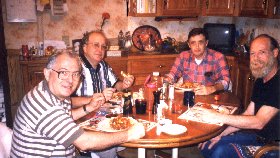
So many large orchestrions tend to be, for all
their vastness and expense a novelty, rather than a profound, legitimate
musical medium in its own right. SOFI, in my opinion, no longer can be compared
to other large orchestrions as another flavor of this curiosity genre. She
was designed to play American music with the same capabilities as live musicians
and as such, her performances are far more inspirational, complex, subtle,
and spontaneous than that which one expects from an automatic musical instrument.
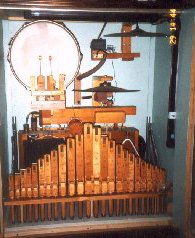 SOFI is an all-American instrument
with an American nature. She was voiced away from the European sounds as
well as the theater organ genre, preferring a luminous, energetic, and unique
personality ideally suited to play American music. Aeolian free reeds,
smooth string pipes, and octave flute ranks with a moderate tremolo contribute
to this tonal nature. To my mind, it is out of character in American jazz
that she be voiced deep and heavy, or that she be given novelty pipe ranks
which do not blend together well. Her solid style of voicing makes SOFI
extremely versatile. Her forte is Classics and Gershwin, Blues and Broadway,
Jazz and Novelty, Ballads and Waltzes, Marches and Scat. Tonal color and
contrast is expanded with pipes that unify and embellish each other so well.
A tonal kaleidoscope of combinations are prolific, and because at any given
moment there might be from one to 50
SOFI is an all-American instrument
with an American nature. She was voiced away from the European sounds as
well as the theater organ genre, preferring a luminous, energetic, and unique
personality ideally suited to play American music. Aeolian free reeds,
smooth string pipes, and octave flute ranks with a moderate tremolo contribute
to this tonal nature. To my mind, it is out of character in American jazz
that she be voiced deep and heavy, or that she be given novelty pipe ranks
which do not blend together well. Her solid style of voicing makes SOFI
extremely versatile. Her forte is Classics and Gershwin, Blues and Broadway,
Jazz and Novelty, Ballads and Waltzes, Marches and Scat. Tonal color and
contrast is expanded with pipes that unify and embellish each other so well.
A tonal kaleidoscope of combinations are prolific, and because at any given
moment there might be from one to 50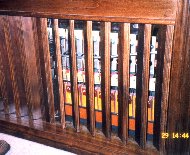 or more pipes playing, the tonal power, density, and harmonic content
must be heard in person to be understood. A recording can only take us
so far. SOFI, heard live, immerses the listener into a theater of pure
music.
or more pipes playing, the tonal power, density, and harmonic content
must be heard in person to be understood. A recording can only take us
so far. SOFI, heard live, immerses the listener into a theater of pure
music.
One very necessary element in American music is rhythm that requires both
a percussion lead and interplay. SOFI has been given a set of fast, expressive,
effortless traps that allow an arranger the full potential of this basic
element of all pop and classical orchestras. What has only been approximated
for so long in automatic live music has finally been born into this instrument.
You will hear some exciting, lifelike percussion, including off-the-beat
hot licks, asymmetric rhythms and patterns that no other automatic instrument
has to date achieved, musically.
SOFI cannot really be understood until she has been experienced. You be
the judge. She is bold and saucy. She has a sweet side and a brash one.
She can holler, and she can seduce. I think you will like all of her complex
facets, moods, colors, and effects. That's what good music played well
really requires. Three words describe SOFI: Fascinating. Addictive. Inspiring!
Pardon my obvious bias. You will keep coming back to this one.
|
The Mechanical Side of SOFI
|
 SOFI uses 10 ranks of pipes, two of which are considered
"Accompaniment ranks." She has Aeolian Reeds, Flute Sax, Diapason, Open
Flutes, Viols and Celeste, Octave Sax and Octave Diapason ranks for the
solo section. While that's 8 solo ranks, the Viols and re-voiced Celeste
play together for a desired coloration. The accompaniment 8' section is
composed of re-voiced Gedeckts and metal flutes.
SOFI uses 10 ranks of pipes, two of which are considered
"Accompaniment ranks." She has Aeolian Reeds, Flute Sax, Diapason, Open
Flutes, Viols and Celeste, Octave Sax and Octave Diapason ranks for the
solo section. While that's 8 solo ranks, the Viols and re-voiced Celeste
play together for a desired coloration. The accompaniment 8' section is
composed of re-voiced Gedeckts and metal flutes.
SOFI has a delightful percussion section which includes the sound effect
toy counter. These are: Bass Drum, 2 Timpani, Ride cymbal, Crash cymbal,
Chinese Gong, Snare tap and Snare reiterator, Wood Block, Triangle, Tambourine,
Temple Block, Cow Bell. The manual effects are; Train whistle, Large Bell,
Bird Whistle, Nest of Bells, Horse's Hooves.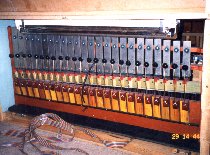
The solo percussion instruments are a Behning Piano, wooden bar xylophone,
and metal bar xylophone. The orchestra bells, as they are called, are specially
built to play along with the wooden xylophone by a special pneumatic circuit
that turns off their reiterators, but when they take the solo, their reiterators
function normally. These metal bars are large and heavy and tend to ring
for a long time, so designed into this system is a set of dampers which
dampen each bar between strikes. This clarifies the tone considerably and
cleans it up. The orchestra bells sit behind the lower set of walnut shutters
in the center section, opening each time they play.
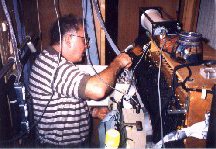 The expression equipment consists of a vacuum dynamic
ranging from over 30" of vacuum to a mere 12-15," via an Ampico rotary
pump. Expression is achieved by "Hickman Curtains" in the expression circuit.
The curtains are very fast and precise, and do not rely on spring tension,
but are relative to the demand of the instrument they control. So despite
the number of notes on or off at any given time, the regulator exactly compensates
and the power delivered to a dozen notes or a single note is exactly the
same.
The expression equipment consists of a vacuum dynamic
ranging from over 30" of vacuum to a mere 12-15," via an Ampico rotary
pump. Expression is achieved by "Hickman Curtains" in the expression circuit.
The curtains are very fast and precise, and do not rely on spring tension,
but are relative to the demand of the instrument they control. So despite
the number of notes on or off at any given time, the regulator exactly compensates
and the power delivered to a dozen notes or a single note is exactly the
same.
There are 4 pipe chests in SOFI, all "circle-winded" to improve the flow
of air regardless of the demand in any particular chest. Each chest has
an input and an output to stabilize flow. The pipes blow at 8" of wind.
This relatively high pressure has the extra advantage of providing much
more 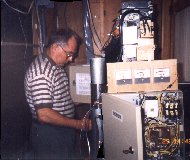 harmonic content, as the pipe overtones are considerably increased. It
also allows a single pipe when desired, to solo in the accompaniment without
getting lost in the arrangement. That makes for another nice effect and
an advantage to the arranger. SOFI uses a Mohler exhaust tremolo in the
pipe circuit, and a Ventus blower.
harmonic content, as the pipe overtones are considerably increased. It
also allows a single pipe when desired, to solo in the accompaniment without
getting lost in the arrangement. That makes for another nice effect and
an advantage to the arranger. SOFI uses a Mohler exhaust tremolo in the
pipe circuit, and a Ventus blower.
There are 2 "O" roll spoolframes always loaded with rolls, which SOFI is
also able to play. These rolls drive a vacuum to electric interface, and
every note then operates a small signal relay in the Note Box. So everything
is played from these relays. Also operated from these signals are the Logic
Circuits which determine how SOFI's pipe ranks and percussion instrumentation
will be multiplexed. Many of these functions do not appear on O rolls, but
could actually be cut into them, and they would not adversely affect any
other "O" roll instrument these may also play on in the future.
SOFI is primarily a MIDI operated instrument, however. That means, she
is played by a computer interfacing with her relays, just like the rolls
do, except the computer operates the relays directly and not through the
roll interface switch banks. The computer and MIDI converter are not actually
a part of SOFI. They are her media, providing a musical input signal, just
like a roll would do.
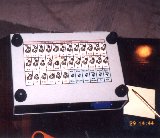 There is a box connected to SOFI called the Remote
Box. This is a control box that allows her lights turned on manually, as
well as any rank of pipes switched on or off at any time, as well as all
the percussion and even sound effects operated from the coffee table. The
real advantage is when a standard "O" rolls is being played. With this box,
you are able to orchestrate to your heart's content. But the remote box
is also able to test every function of this instrument as well. Its 7 connectors
allow a servicing of the instrument that is almost automatic, as well as
a full tuning, since its tuning switches for every pipe in the machine are
normally upside down, hidden on the bottom of the box.
There is a box connected to SOFI called the Remote
Box. This is a control box that allows her lights turned on manually, as
well as any rank of pipes switched on or off at any time, as well as all
the percussion and even sound effects operated from the coffee table. The
real advantage is when a standard "O" rolls is being played. With this box,
you are able to orchestrate to your heart's content. But the remote box
is also able to test every function of this instrument as well. Its 7 connectors
allow a servicing of the instrument that is almost automatic, as well as
a full tuning, since its tuning switches for every pipe in the machine are
normally upside down, hidden on the bottom of the box.
 Reliability and ease of access was paramount
in this design. Since only machinery that is easy to service is going to
get serviced, SOFI was designed to service. She has a full set of schematics
and documentation. All her circuits are divided into 4 steel boxes which
detach from the back and sides of the piano for ease of inspection. There
are no circuit cards and no solid state in these boxes, except for the
power supplies. The 3 solo pipe chests can be stripped to tune in less than
10 minutes, including the removal
Reliability and ease of access was paramount
in this design. Since only machinery that is easy to service is going to
get serviced, SOFI was designed to service. She has a full set of schematics
and documentation. All her circuits are divided into 4 steel boxes which
detach from the back and sides of the piano for ease of inspection. There
are no circuit cards and no solid state in these boxes, except for the
power supplies. The 3 solo pipe chests can be stripped to tune in less than
10 minutes, including the removal 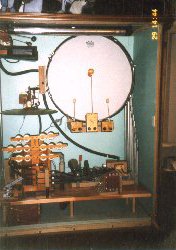 of the xylophone. The accompaniment chest is already open from the back
and easily tuned. It is possible for one man to tune the entire instrument.
Repairs on the solo pipe valves are easily made without removing any pipes.
They can be fixed from the bottoms, which drop away for full access.
of the xylophone. The accompaniment chest is already open from the back
and easily tuned. It is possible for one man to tune the entire instrument.
Repairs on the solo pipe valves are easily made without removing any pipes.
They can be fixed from the bottoms, which drop away for full access.
The case of SOFI is a "pre-fab," and most of the panels are flat. The widest
would be the solo chests, which are 6" deep. She sits on a "shadow foundation
board," which forms her outline on the floor and connects together with
couplings. This type of foundation relies on shims to be made level. At
present, SOFI sits mostly on carpet, and partly on a hard floor, and yet
has remained perfectly fitted. Her front is still exactly vertical. 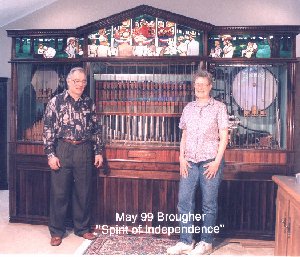 Her panels are drawn together with 1/4-20 bolts and threaded inserts,
mostly, and the core wood used is Medex, a stable, fine-grained wood product
that machines as well as plastic composites. It is neither flake board or
the common counter top material, but a very high quality, stable composition
board that allows a highly precision construction. The other members are
fabricated vertical beams and a long rear horizontal truss beam for light
weight and strength, and are mortised together as a single structural member,
yet as strong as solid wood of the same cross section. Oak "T" beam rafters
are then set into slots in the top horizontal joists to complete the construction.
Simple and efficient.
Her panels are drawn together with 1/4-20 bolts and threaded inserts,
mostly, and the core wood used is Medex, a stable, fine-grained wood product
that machines as well as plastic composites. It is neither flake board or
the common counter top material, but a very high quality, stable composition
board that allows a highly precision construction. The other members are
fabricated vertical beams and a long rear horizontal truss beam for light
weight and strength, and are mortised together as a single structural member,
yet as strong as solid wood of the same cross section. Oak "T" beam rafters
are then set into slots in the top horizontal joists to complete the construction.
Simple and efficient.
|
How Arrangements
Are Made
|
When I arrange a tune for SOFI, I first
look through the available arrangements that I already have. How can I
beat an Ampico or Duo-Art arrangement? So that's what I go for, because
they have so much potential!
Occasionally,
I will arrange a song from scratch. The difference between doing it that
way and picking a great arrangement already available is usually 2-3 weeks
of time. Granted, I might not keep much of the original scoring, because
so many changes have to be made, but beginning this way is often faster because
of the placement of the notes in the melody line. Also, their arrangements
gives me the opportunity to improve on them, often as not. After all, SOFI
can provide more complex melody interplay than can a piano alone.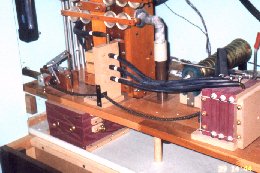
Doing your
own arrangements from scratch are sometimes more satisfying and often necessary,
and there are many songs that were never recorded on rolls that need more
exposure and a fresh approach, so in that case, I would choose a totally
new arrangement.
I am a musician
but not by trade. Therefore, my time is limited to what I can afford to
give these personal arrangements. There are other musician/arrangers who
do this as part of their livelihood and these people will truly appreciate
SOFI's "friendliness" and capacity to make their arrangements sound spectacular.
One reason is because SOFI has few limitations compared to most orchestrions.
It's so nice to hear in your mind's ear what you intend to let everyone
else hear for the first time. As an arranger, you don't have to make as
many concessions regarding the limitation of the mechanics, like the number
of pipes playing at any given time, or the rapidity you can expect from
your percussion, or the overall drain on the vacuum and pressure resources
to the overall arrangement and its requirements. This makes arranging music
for SOFI less time-consuming and therefore, cheaper. It also allows for
much more complex arrangements and in particular, the percussion track.
The main reason
arrangements for SOFI are so reasonable is that she was designed to be
easily programmed. Her "O" roll scale is "intuitive." Her presets and multiplexing
are done on the same computer program the notes are placed on, just like
a player roll. That program is called Cakewalk, available for sale in computer
stores. The setup program which conforms Cakewalk for SOFI's own use has
already been written by George Bogatko and available from him so the format
requirements are quite simple. Connected to SOFI and sitting at the computer
terminal is also a handy indicator box that shows which presets and instruments
are on and off. As you activate certain switches on the computer screen,
the box changes accordingly, and LEDs turn on and off to indicate. There's
no question what it was you did. That little box also contains switches to
do the same thing manually. This is not the Remote Box mentioned earlier.
Another nice
feature for any arranger is that her ranks and presets can be switched
instantly, as you will notice, even splitting a musical phrase (when you
get the knack of it), and this is a capacity that is not heard in any other
orchestrion. It is a capacity however that is allowed by the "O" roll original
format when multiplexed. Yet the level of SOFI technology is identical to
turn-of-the-century technology except for the medium the music is on, and
the advantage of that old technology is the ultimate reward: Reliability
and Repair-ability. Her other strong advantage is her amenability to play
new arrangements with a minimum of adjustments and special consideration
for instrument limitations, so common in other similar instruments. The
end result of these musical advantages is that SOFI won't bleed its owner
dry trying to afford it new songs or tunings and repairs. As a matter of
fact, most people with a musical background would have fun arranging their
own tunes, given the chance.
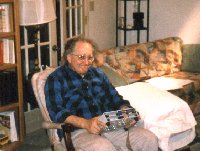 We did not want to offer recordings until we felt that
they would do SOFI some semblance of justice. The following 5 CDs are an
example of a new, budding technology for home recording buffs called Direct
Digital Recording. It is done straight into an audio-digital USB terminal
called an audio-USB converter, and into a computer. These recordings have
not been doctored, and are as true to life as I could get them. I am pleased
with the way they turned out.
We did not want to offer recordings until we felt that
they would do SOFI some semblance of justice. The following 5 CDs are an
example of a new, budding technology for home recording buffs called Direct
Digital Recording. It is done straight into an audio-digital USB terminal
called an audio-USB converter, and into a computer. These recordings have
not been doctored, and are as true to life as I could get them. I am pleased
with the way they turned out.
|

